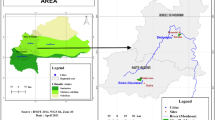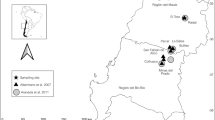Abstract
Several insect species visited exotic Rhododendron ponticum flowers, but bumblebees were most common. Only bumblebees (and one Vespula) contacted the flower stigma whilst foraging and are probably the main pollinators. One-third of insect visits resulted in stigma contact and visitation rates were high. This explains the high seed set reported elsewhere. There were significant differences according to the body size of visitors, with large queen bees contacting stigmas more often than smaller workers. There were no significant differences in behaviour of three species (Bombus jonellus, B. lucorum and B. monticola) and all bees tended to move short distances between flowers on a single plant. Longer flights and movements among plants were rare. Pollen carryover was estimated to be high: there was no decline in the amount of pollen deposited on stigmas from the first to fifth flower visited. The impact of bee behaviour on reproduction and invasion by exotic R. ponticum is discussed.
Zusammenfassung
Das Verhalten von Blüten besuchenden Insekten beeinflusst den Umfang und die Qualität der Bestäubung für Pflanzen und beeinflusst damit sowohl die individuelle Fitness der Pflanze als auch die Populationsdynamik. Entomogame exotische Pflanzen müssen bezüglich ihrer Bestäubung mutualistische Beziehungen mit einheimischen Bestäubern bilden, um sich in fremden Habitaten durchzusetzen und zu verbreiten. Dadurch können einheimische Bestäuber einen direkten Einfluss auf die Verbreitung invasiver exotischer Pflanzen haben. Die invasive Art Rhododendron ponticum in Irland wird von einer ganzen Reihe von Insekten besucht, doch hatten bei zwei eingebürgerten Populationen in der Region Dublin lediglich Hummeln und eine Wespenkönigin Kontakt mit der Narbe. Bei einer Erhebung während der Hauptblütezeit im Jahr 2002 waren Hummeln die häufigsten Blütenbesucher mit mehr als einem Besuch pro Stunde. Dies erklärt die enorme Samenproduktion und die erfolgreiche Invasion dieser Art. Sechs Hummelarten (bestehend aus 15 % Königinnen, 73 % Arbeiterinnen und 12 % Drohnen) wurden beim Blütenbesuch und Nektar-bzw. Pollensammeln beobachtet. Es gab keinen signifikanten Unterschied zwischen Pollen und/oder Nektar sammelnden Insekten bezüglich ihrer Bestäubung (bestimmt über den Anteil Besucher mit Kontakt zur Narbe, Abb. 1). Allerdings hatten größere Insekten (meist Königinnen) eher Kontakt mit den Narben als kleinere Insekten wie Arbeiterinnen oder Drohnen (Abb. 2). Die lediglich geringen Unterschiede im Sammelverhalten der verschiedenen Hummelarten (Tab. II) sprechen dafür, dass diese Arten eine einheitliche funktioneile Bestäubergruppe bilden. R. ponticum bilden enorme Blütenansammlungen. Analysiert man die Flugaktivitäten der Hummeln, so bewegen sich 47,5 % innerhalb eines Blütenstandes, 50,1 % zwischen Blütenständen und 2,4 % zwischen verschiedenen Pflanzen. Zwischen zwei Blütenbesuchen wurden meist nur kurze Distanzen zurückgelegt (Abb. 3), was zu hohen Inzuchtraten führen könnte. Verstärkt werden könnte dies durch die Fähigkeit von R. ponticum zu lokaler vegetativer Verbreitung, wodurch benachbarte Pflanzen Klone sein könnten. Dadurch könnten selbst als Auskreuzung interpretierte Bestäubungsvorgänge zu Inzucht führen. Möglicherweise ist die Pollenübertragung aber sehr weit reichend, da es keine Abnahme der übertragenen Pollenmenge bei aufeinander folgenden Blütenbesuchen gab (Tab. III). Hummeln haben demnach als der primäre Bestäuber für R. ponticum in Irland eine wichtige Bedeutung für das Auskreuzen und die Populationsdynamik dieser exotischen Pflanzenart.
Similar content being viewed by others
References
Augspurger C.K. (1980) Mass-flowering of a tropical shrub (Hybanthus prunifolius): influence on pollinator attraction and movement, Evolution 34, 475–488.
Barthell J.F., Randall J.M., Thorp R.W., Wenner A.M. (2001) Promotion of seed set in yellow star-thistle by honey bees: evidence of an invasive mutualism, Ecol. Appl. 11, 1870–1883.
Broyles W.S.B., Wyatt R. (1991) Effective pollen dispersal in a natural population of Asclepias exalata: the influence of pollinator behaviour, genetic similarity and mating success, Am. Nat. 138, 1239–1249.
Buchmann S.L., Nabhan G.P. (1996) The forgotten pollinators, Island Press, Washington DC.
Carré S., Badenhauser I., Taséi J.N., Le Guen J., Mesquida J. (1994) Pollen deposition by Bombus terrestris L., between male-fertile and male-sterile plants in Vicia faba L., Apidologie 25, 338–349.
Chittka L., Schurkens S. (2001) Successful invasion of a floral market, Nature 411, 653.
Cresswell J.E. (2000) A comparison of bumblebees’ movements in uniform and aggregated distributions of their forage plants, Ecol. Entomol. 25, 19–25.
Cresswell J.E., Bassorn A.P., Bell S.A., Collins S.J., Kelly T.B. (1995) Predicted pollen dispersal by honeybees and three species of bumblebees foraging on oilseed rape: a comparison of three models, Funct. Ecol. 9, 829–841.
Cross J.R. (1981) The establishment of Rhododendron ponticum in the Killarney oakwoods, S.W. Ireland, J. Ecol. 69, 807–824.
De Jong T.J., Waser N.M., Price M.V., Ring R.M. (1992) Plant size, geitonogamy and seed set in Ipomosis aggregata, Oecologia 89, 310–315.
De Jong T.J., Waser N.M., Klinkhamer P.G.L. (1993) Geitonogamy — the neglected side of selfing, Trends Res. Ecol. Evol. 8, 321–325.
Elton C.S. (1958) The ecology of invasions by animals and plants, Methuen, London.
Erfmeier A., Bruelheide H. (2004) Comparison of native and invasive Rhododendron ponticum populations: growth, reproduction and morphology under field conditions, Flora 199, 120–133.
Escaravage N., Wagner J. (2004) Pollination effectiveness and pollen dispersal in a Rhododendron ferrugineum (Ericaceae) population, Plant Biol. 6, 606–615.
Fenster C.B., Armbruster W.S., Wilson P., Dudash M.R., Thomson J.D. (2004) Pollination syndromes and floral specialization, Annu. Rev. Ecol. Syst. 35, 375–403.
Geber M.A. (1985) The relationship of plant size to self-pollination in Mertensia ciliata, Ecology 66, 762–772.
Ghazoul J. (2002) Flowers at the front line of invasion? Ecol. Entomol. 27, 639–640.
Goulson D. (2003) Bumblebees: their behaviour and ecology, Oxford University Press.
Goulson D., Derwent L. (2004) Synergistic interactions between an exotic honeybee and an exotic weed: pollination of Lantana camara in Australia, Weed Res. 44, 195–202.
Hanley M.E., Goulson D. (2003) Introduced weeds pollinated by introduced bees: cause or effect? Weed Biol. Manage. 3, 204–212.
Herrera C.M. (1987) Components of pollinator ‘quality’: comparative analysis of a diverse insect assemblage, Oikos 50, 79–90.
Inouye D.W. (1983) The ecology of nectar robbing, in: Elias T.S., Bentley B. (Eds.), The biology of nectaries, Columbia University Press, New York, pp. 152–173.
Keller L.F., Waller D.M. (2002) Inbreeding effects in wild populations, Trends Res. Ecol. Evol. 17, 230–241.
King M.J., Buchmann S.L. (1995) Bumblebee initiated vibration release mechanism of Rhododendron pollen, Am. J. Bot. 82, 1407–1411.
Klinkhamer P.G.L., de Jong T.J. (1990) Effects of plant size, plant density and sex differential nectar reward on pollinator visitation in the protandrous Echium vulgare (Boraginaceae), Oikos 57, 399–405.
Klinkhamer P.G.L., de Jong T.J. (1993) Attractiveness to pollinators — a plants dilemma, Oikos 66, 180–184.
Klinkhamer P.G.L., de Jong T.J., De Bruyn G.J. (1989) Plant size and pollinator visitation in Cynoglossum officinale, Oikos 54, 201–204.
Lande R. (1995) Mutation and conservation, Conserv. Biol. 9, 782–791.
Lee P.L.M., Patel R.M., Conlan R.S., Wainwright S.J., Hipkin C.R. (2004) Comparison of genetic diversities in native and alien populations of hoary mustard (Hirschfeldia incana (L.) Lagreze-Fossat), Int. J. Plant Sci. 165, 833–843.
Levin D.A. (1978) Pollinator behaviour and the breeding structure of plant populations, in: Richards A.J. (Ed.), The pollination of flowers by insects, Academic Press, London, pp. 133–150.
Macior L.W. (1970) The pollination ecology of Dicentra cucullaria, Am. J. Bot. 57, 6–11.
Mejías J.A., Arroyo J., Ojeda F. (2002) Reproductive ecology of Rhododendron ponticum (Ericaceae) in relict Mediterranean populations, Bot. J. Linn. Soc. 140, 297–311.
Milne R.I., Abbott R.J. (2000) Origin and evolution of invasive naturalized material of Rhododendron ponticum L. in the British Isles, Mol. Ecol. 9, 541–556.
Morales C.L., Aizen M.A. (2006) Invasive mutualisms and the structure of plant-pollinator interactions in the temperate forests of north-west Patagonia, Argentina, J. Ecol. 94, 171–180.
Parker I.M. (1997) Pollinator limitation of Cytisus scoparius (Scotch broom), an invasive exotic shrub, Ecology 78, 1457–1470.
Parker I.M., Haubensak K.A. (2002) Comparative pollinator limitation of two non-native shrubs: do mutualisms influence invasions? Oecologia 130, 250–258.
Richardson D.M., Allsopp N., D’Antonio C.M., Milton S.J., Rejmanek M. (2000) Plant invasions — the role of mutualisms, Biol. Rev. Camb. Phil. Soc. 75, 65–93.
Sokal R.R., Rohlf F.J. (1995) Biometry — the principles and practice of statistics in biological research (3rd ed.), W. H. Freeman & Co., New York.
Stout J.C. (2000) Does size matter? Bumblebee behaviour and the pollination of Cytisus scoparius L. (Fabaceae), Apidologie 31, 129–139.
Stout J.C. (2007) Reproductive biology of the invasive exotic shrub, Rhododendron ponticum L. (Ericaceae), Bot. J. Linn. Soc.
Stout J.C., Kells A.R., Goulson D. (2002) Pollination of the invasive exotic shrub Lupinus arboreus (Fabaceae) by introduced bees in Tasmania, Biol. Conserv. 106, 425–434.
Stout J.C., Parnell J.A.N., Arroyo J., Crowe T.P. (2006) Pollination ecology and seed production of Rhododendron ponticum in native and exotic habitats, Biodivers. Conserv. 15, 755–777.
Traveset A., Richardson D.M. (2006) Biological invasions as disruptors of plant reproductive mutualisms, Trends Res. Ecol. Evol. 21, 208–216.
Valentine D.H. (1978) The pollination of introduced species, with special reference to the British Isles and the genus Impatiens, in: Richards A.J. (Ed.), The pollination of flowers by insects, Academic press, London, pp. 117–123.
Waddington K.D. (1981) Factors influencing pollen flow in bumblebee-pollinated Delphinium virescens, Oikos 37, 153–159.
Wallace L.E. (2003) The cost of inbreeding in Platanthera leucophaea (Orchidaceae), Am. J. Bot. 90, 235–242.
Author information
Authors and Affiliations
Corresponding author
Additional information
Manuscript editor: Jacqueline Pierre
Rights and permissions
About this article
Cite this article
Stout, J.C. Pollination of invasive Rhododendron ponticum (Ericaceae) in Ireland. Apidologie 38, 198–206 (2007). https://doi.org/10.1051/apido:2006071
Received:
Revised:
Accepted:
Issue Date:
DOI: https://doi.org/10.1051/apido:2006071




